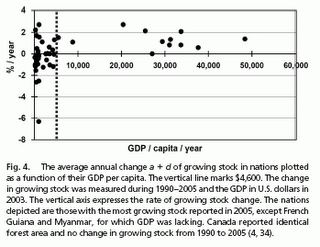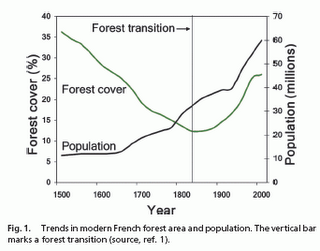Reforestation and GDP
Researchers led by Pekka Kauppi of the University of Helsinki in Finland sought to identify exactly how much carbon is stored in the world's forests. They analysed reports on the state of forests in 50 countries in 1990 and 2005 compiled by the United Nations Food and Agriculture Organisation. They also used information contained in national databases dating back hundreds of years.Sounds consistent with what I blogged about earlier. Forests in temperate countries are increasing but tropical ones are decreasing but at a faster rate. The key to stopping the decline lies in Brazil and Indonesia.
The researchers calculated that the “forest identity” had increased over the past 15 years in 22 of the world's 50 most forested countries. Forests are also gaining ground in the world's two most populous countries, India and China. Other Asian countries that have gone from deforestation to afforestation include South Korea and Vietnam.
Globally, the total number of trees and associated organic matter has fallen year on year, in some places for as long as records have existed. Poor management in Brazil and Indonesia has been a particular problem: both countries lost greater volumes of timber than America and China even though America and China harvested more wood.
 What I found new and interesting was this part.
What I found new and interesting was this part.The results, published in the Proceedings of the National Academy of Sciences, show that in all the countries that have a GDP per head of $4,600 or more—making them richer than, say, Chile—forests are recovering.
The researchers argue that the trend is partly the result of social changes that occur as countries develop and become wealthier, such as the movement of rural dwellers to cities. Urbanisation decreases the likelihood of trees being felled for heating and building.
 Higher GDP leads to reforestation. This would make one think that GDP growth is good for forests. I think it is a little more complicated as this graph of France shows. It displays a classic environmental Kuznets curve where GDP growth starts by decreasing the number of forests and then reverses at higher incomes and forests increase again. But, as this graph shows the recovery has yet to reach the pre-industrialization level.
Higher GDP leads to reforestation. This would make one think that GDP growth is good for forests. I think it is a little more complicated as this graph of France shows. It displays a classic environmental Kuznets curve where GDP growth starts by decreasing the number of forests and then reverses at higher incomes and forests increase again. But, as this graph shows the recovery has yet to reach the pre-industrialization level. via The Economist and Nobel Intent







2 comments:
I think the idea of a re-forestation Kuznet's curve is worth pursuing, but I feel the need to point out that the graph you display doesn't show the Kuznet's curve you describe since it relates forestation to population and not per capita income.
Hi jte,
You are correct that the chart doesn't show per capita income. I just assumed that per capita income would be going up over the time frame specified. I also wish there was a version of the graph with GDP/capita on it. At what level of GDP/capita does the forest transition occur?
Population is interesting in that even though it is increasing, level of reforestation is still going up.
Post a Comment
Note: Only a member of this blog may post a comment.